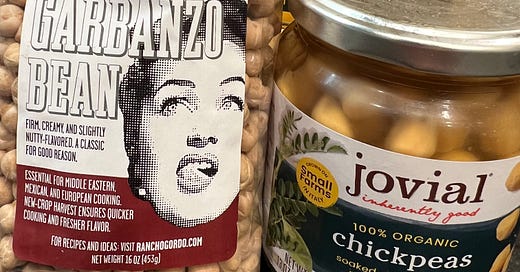This week the summer farmer’s market begins on Wednesdays in my corner of the world. It has been chillier than normal this spring and when I read the summer market begins this week I thought I was mistaken. Not at all. Quick mindset shift and I am already thinking, should I walk or drive? Will there be a diverse amount of veggies that will catch my eye? In that case I will need to drive because hauling all that produce and walking will not be in my best interest. But the sun is shining this week so it may be a game day decision.
I am also excited because I received my second quarter Rancho Gordo bean box this weekend. I actually filmed myself opening it the other day and then I thought, what am I doing with this? I might upload it to YouTube and then I can share it here…unedited. Well I did just that. If you’re curious about my quarterly delivery, take a peek.
Obviously I do not have a “team”. It's just me, can you tell? One of the first things I knew I would be making is the Garbanzo beans. Actually I wanted to make the spring lima beans first but I need a minute to think about what I am doing there. Just like I need a minute to learn how to properly edit my video. I can’t imagine why someone would not want to watch me squint to read the bean labels. But heck, its me and I am learning everyday. The editing is easy enough, it’s getting comfortable with the YouTube software; I will edit one of my millions of “how to make beans from scratch” videos for next time. Back to the subject of beans: I eat chickpeas weekly but I don’t know how often I share my chickpea ideas in this Substack, especially as we move into summer. Let me check, I’ll be right back.
Alrighty, I began my Substack on July 4, 2023, and then began sharing recipes two weeks later on my third newsletter. I made hummus; ha, ha, I started with chickpeas. I did not realize that. Then, in December, I shared some breakfast ideas and talked about brothy chickpeas. So twice I spoke of chickpeas in 46 weeks. I seem to lean on black beans as it is a friendly bean to start eating when we have not had beans in our weekly rotation. However, today, it is time to highlight the beautiful garbanzo bean.
Origin and History
Garbanzo beans are one of the earliest cultivated legumes, with evidence of their use dating back to around 7,500 years ago in the Middle East. They were a significant crop and were later spread by traders to the Mediterranean, Africa, and India. The name "garbanzo" is derived from the Spanish language for chickpea, while "chickpea" comes from the Latin word "cicer."
Over time, garbanzo beans became integral to various cuisines. Ancient Egyptians enjoyed them in stews, the Greeks and Romans prized them as snacks, and they were a key ingredient in Middle Eastern dishes. Today, they are a global staple, cherished for their versatility and health benefits.
Cultural Significance
Garbanzo beans have woven their way into the culinary traditions of many cultures:
Middle Eastern Cuisine: Perhaps most famously, garbanzo beans are the main ingredient in hummus and falafel. Hummus, a creamy dip made from mashed chickpeas, tahini, lemon juice, and garlic, is a beloved staple in Middle Eastern diets and has made its way across the world. Falafel, deep-fried or pan-fried balls or patties made from ground chickpeas, are a very popular item as well.
Indian Cuisine: In India, garbanzo beans are used in a variety of dishes, from curries like Chana Masala to snacks like Chana Chaat. They are also ground into besan (chickpea flour), which is used in many recipes, including pakoras and sweets.
Mediterranean Cuisine: Garbanzo beans are a key ingredient in Mediterranean salads and stews. They are often used in soups like the Spanish Garbanzos con Espinacas (chickpeas with spinach) and pasta e ceci (pasta with chickpeas).
North African Cuisine: In Morocco, garbanzo beans are used in traditional dishes like Harira, a hearty soup that is often enjoyed during Ramadan.
American Cuisine: Because we are a melting pot of different cultures we see chickpeas in many westernized versions of the dishes mentioned above. We can readily find dishes in restaurants inspired by cultures who were first to use the chickpea. From chickpeas in pasta, to hummus, to a curry, chickpeas are widely available in the supermarket and perhaps in your pantry right now.
Nutritional Profile
Garbanzo beans are a nutritional powerhouse. Karen Hurd recommends eating ½ cup of beans with each meal. For those of you new to eating beans daily, remember you must slowly work your way up to eating that amount of beans. The Blue Zones centenarians eat 1 cup of beans daily. Therefore, I will break down the nutritional profile based on a 1/2 cup serving (about 82 grams):
Calories: 134
Protein: 7 grams
Fiber: 6 grams
Fat: 2 grams
Carbohydrates: 22 grams
Folate: 35% of the Daily Value (DV)
Iron: 10% of the DV
Phosphorus: 11% of the DV
Manganese: 14% of the DV
Copper: 16% of the DV
Garbanzo beans are also a good source of magnesium, potassium, and vitamin B6. Their high fiber content aids digestion and helps regulate blood sugar levels, making them a great addition to our balanced diet.
Don’t throw out chickpea liquid, either from canned beans or from cooking the bean! It is called aquafaba, a thick liquid containing a mix of starch and trace amounts of protein, with emulsifying, binding, and thickening properties. It works well as a flavorless, odorless egg replacer in recipes: 1 tablespoon of aquafaba = 1 egg yolk, 2 tablespoons = 1 egg white, and 3 tablespoons = 1 one whole egg. It can also be whipped to replace the eggs in meringues or mayonnaise. (Harvard School of Public Health)
Note: I find the canned aquafaba has much better thickening properties to use as stated above than when I use the liquid from making beans from scratch.
Recommended Recipe
Springtime chickpea salad
Because it is sunny and bright today and the farmers market is opening this week I may have a false sense of summer on the horizon. I made this salad this weekend to bring to my Uncle’s birthday celebration and I thought it was crisp. I left the salad with them and I have craving to have it again so I thought why not share it here. It is easy peasy to whip up and you can do it with mostly pantry ingredients if you have not gone to the farmers market.
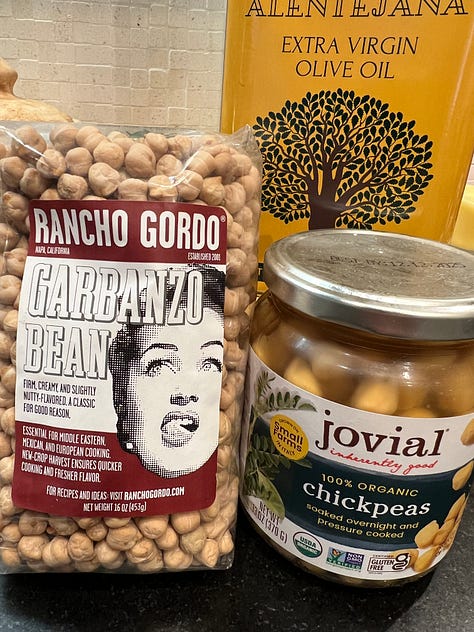
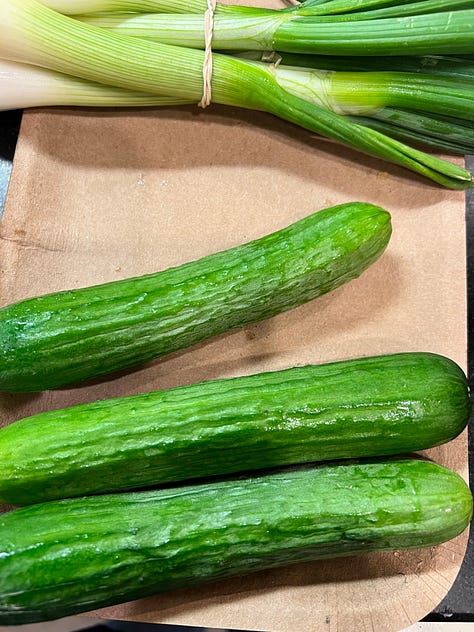

Ingredients:
1 ½ cups cooked, 1 jar, or 1 can (15 oz) garbanzo beans, drained and rinsed
1 cup smaller tomatoes, halved or chopped into quarter-inch/half-inch pieces (I used a mix of campari and grape tomatoes)
3 small cucumbers quartered lengthwise and diced
3 scallions, spring green onions– include both deep green and light green parts or may use 1/4 red onion, thinly chopped
1/4 cup chopped fresh parsley or cilantro (I used parsley over the weekend and cilantro today)
1 tbsp olive oil (optional)
2 tbsp lemon juice
Salt and pepper to taste
Mix everything together. I did not add the oil this time. The tomato, the lemon and the herbs make the most delicious tasting springy salad. I created it without the olive oil, tried it and I preferred it over the one I made on Saturday.
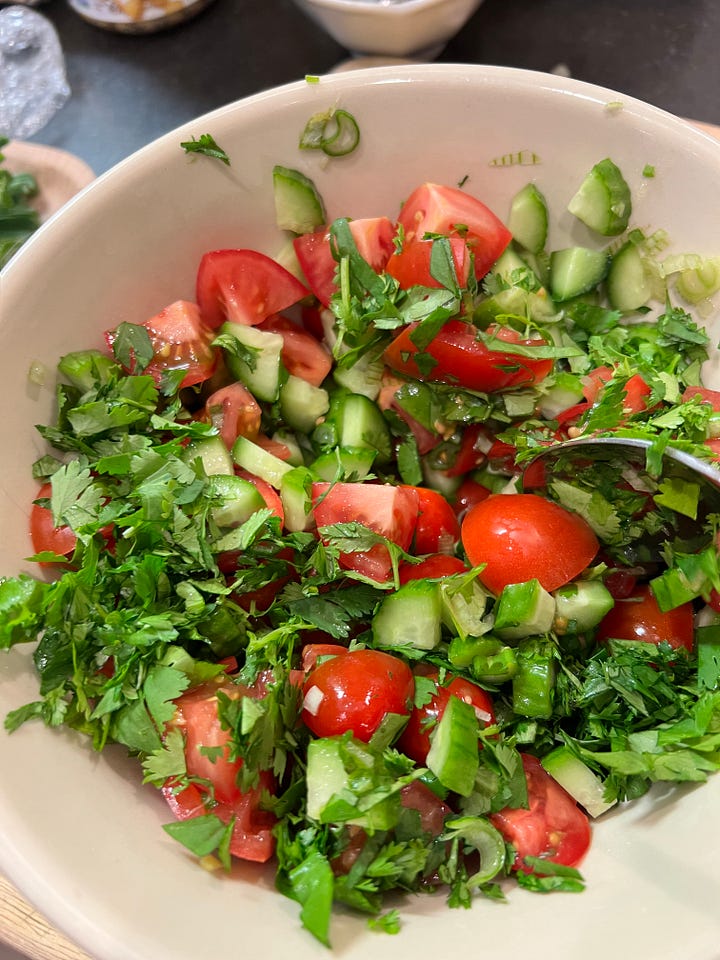
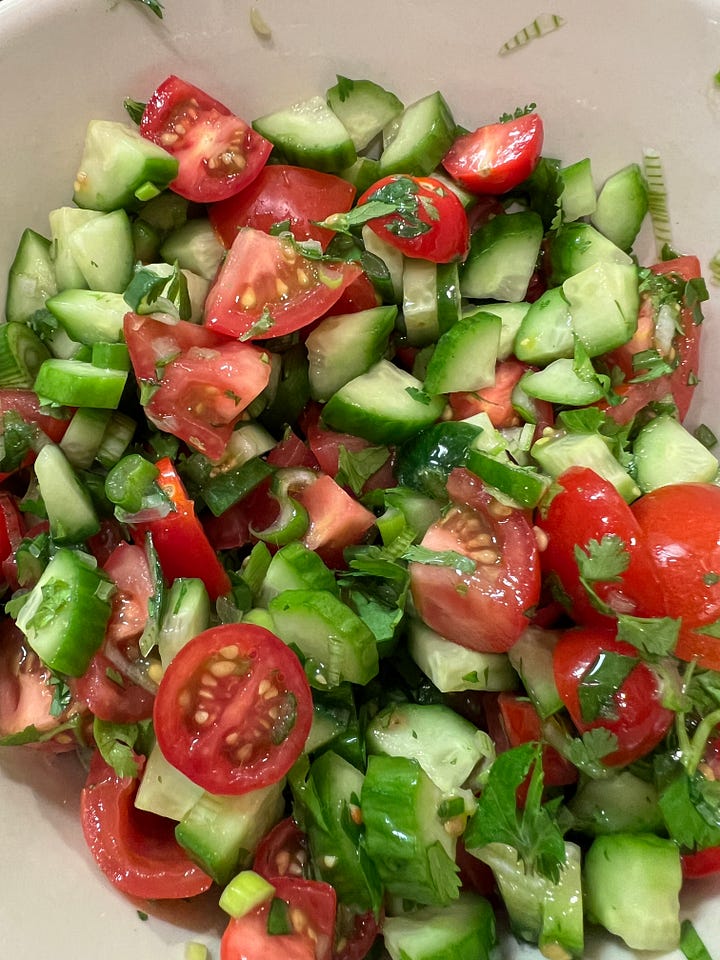
I also decided to keep the chickpeas separate today because someone who might eat this is allergic to them. I could’ve swapped out for another bean and the salad would still be delicious. I put the chickpeas with some seasonings (Newport Sea Salt company) in a bowl to the side as part of an appetizer board with feta cheese, pita bread, etc.
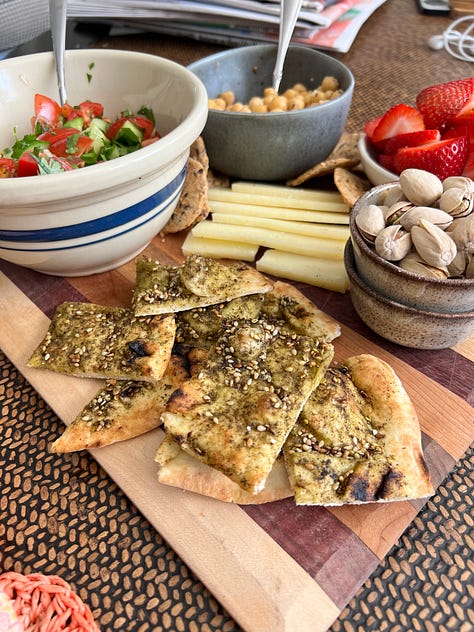
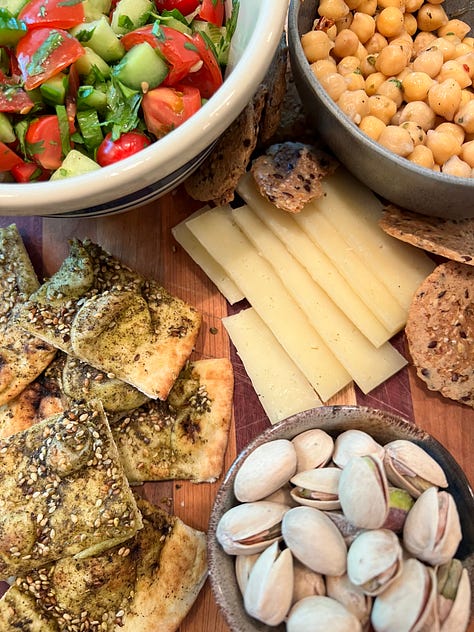
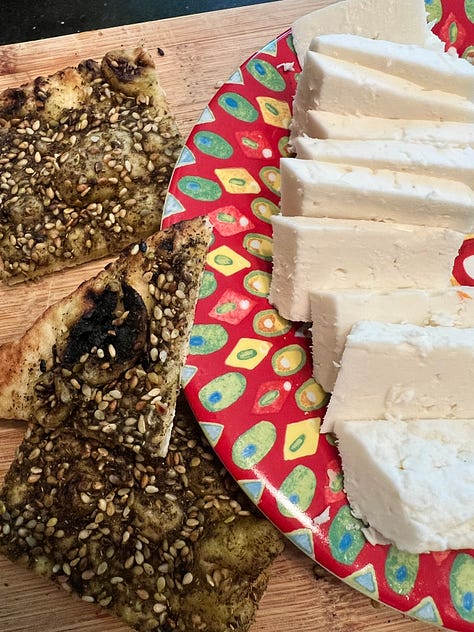
Note: I also put this salad with chickpeas in a glass jelly jar with tuna and avocado (healthy fat) for lunch tomorrow. Feel free to add different herbs. Additionally, you could add red pepper, olives and feta right into the bowl with oregano and make this a Greek spring salad. So many possibilities. Enjoy.
Contact
If you have any questions on integrating beans consistently for gut health now and into the near future, please email me at Denisemancieri1@gmail.com. Feel free to comment below if there are topics you would like to see.
Please share this newsletter with others if you find it may assist them in adding beans to their diet. Or click the heart, below left, so I know you were here. Thank you!
Note: I am not a doctor. I am a teacher and an educator with an earned doctorate in educational leadership. I enjoy research and I can distill large amounts of information into easily understood and digestible pieces allowing people to understand what is happening to their body and possible steps to reverse it with food as medicine. I have healed my own GI issues through choices with food. I followed Karen Hurd’s bean protocol diet, I meditated and still do and I healed. I feel compelled to be in service and educate others as the more people eating beans, alongside a healthy diet and sharing their stories the more people will live a healthier existence. Joy, peace and freedom abound. Please see your doctor and discuss nutritional options before you change any course of action with your health.
Remember to leave your comments below!

